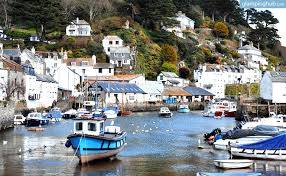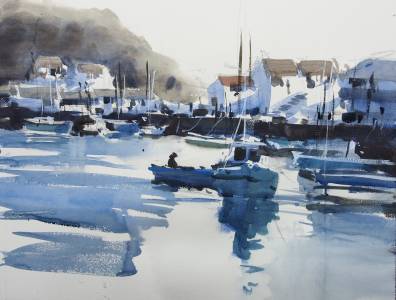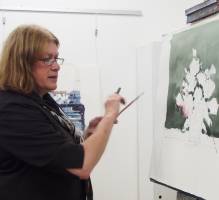AMANDA HYATT demonstration 20th
February 2016
Landscape & Floral Watercolours
 The
huge crowd was a tribute to our guest. Every seat in the building was
brought in and occupied, plus.
The
huge crowd was a tribute to our guest. Every seat in the building was
brought in and occupied, plus.
A record for both attendance and
takings.
Amanda declared herself to be a traditional tonalist realist who uses watercolour. As opposed to a colourist. She revealed her influences and when you compare her work to that of the main one, John Yardley, you can see the resemblances. As a female art professional she has had a hard row to hoe in competition with the excellent male watercolourists that we have in Australia. However success is now hers, as the popularity of this demonstration has shown.
She made the comment that watercolour is the hardest medium in that it does not improve if you go back and do that little bit more to correct it. The words that introduce failure are “I’ll just do this.” So don’t fiddle.
She had as a reference a photo of the harbour at Polperro, Cornwall. She said that you don’t have to copy what is there. It is there to inspire you to do what you decide to do. Leave things out in the interests of composition. Some areas are impossible so fudge it.
Getting down to tintacks she said “Don’t worry about a clean palette. The mud will be useful. Squeeze more paint on top of old paint. I found I had a lovely green; it was mould.” She wasn’t fussy about brushes in terms of expense but she did know what she liked to have for different purposes. Hakes, fans, riggers, mops, they all have their uses. Generally go for the long handled ones if you value looseness.
 She
had a five point plan:
She
had a five point plan:
1. Draw it up.
Think about composition. Where is the horizon? Not halfway. Maybe a third,
or in fifths.
What you leave out is as important as what you put in.
2. Choose colours, just a few.
3. Build up three tones, that’s enough.
4. Create a sense of light, time, magic.
5. Pull it all together. Each
bit connects to some other bit. It may be via the extra thick darks, or
the jewellery with the rigger, or the white gouache highlights. There is
no rule that says you can’t use gouache in watercolour.
The result was a lovely view of Polperro harbour in restful blues, a tonal painting which captured the light, as opposed to a colourful one.
 After
a lovely afternoon tea she came back to do a floral painting. Composition?
Where is the light coming from? Top right. If so where do the shadows
fall? She sketched some flowers in a vase on a shiny wood surface. She
decided on colours – pinks, greens, whites. Then she started painting the
negative areas behind the flowers in a mixture of viridian, burnt sienna
and cerulean. She kept the paint flowing, following the bead. It was
action painting. Watercolour has to be quick. Plenty of water. Push it
around. Once the vase and its shadow were done she mixed a light wash of
gouache for some lace curtains.
After
a lovely afternoon tea she came back to do a floral painting. Composition?
Where is the light coming from? Top right. If so where do the shadows
fall? She sketched some flowers in a vase on a shiny wood surface. She
decided on colours – pinks, greens, whites. Then she started painting the
negative areas behind the flowers in a mixture of viridian, burnt sienna
and cerulean. She kept the paint flowing, following the bead. It was
action painting. Watercolour has to be quick. Plenty of water. Push it
around. Once the vase and its shadow were done she mixed a light wash of
gouache for some lace curtains.
The result – soft flowers sitting in a window.
“I’m done,” she said.
Two lovely paintings in a couple of hours. That’s watercolour.
Report by Colin Browne